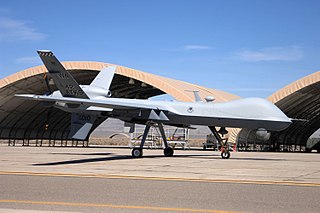Related Research Articles

The Boeing RC-135 is a family of large reconnaissance aircraft built by Boeing and modified by a number of companies, including General Dynamics, Lockheed, LTV, E-Systems, and L3 Technologies, and used by the United States Air Force and Royal Air Force to support theater and national level intelligence consumers with near real-time on-scene collection, analysis and dissemination capabilities.

Beale Air Force Base (AFB) is a United States Air Force base located approximately 8 miles (13 km) east of Marysville, California. It is located outside Linda, about 10 miles (16 km) east of the towns of Marysville and Yuba City, and about 40 miles (64 km) north of Sacramento.

The Lockheed EC-121 Warning Star was an American airborne early warning and control radar surveillance aircraft operational in the 1950s in both the United States Navy (USN) and United States Air Force (USAF).

Creech Air Force Base is a United States Air Force (USAF) command and control facility in Clark County, Nevada used "to engage in daily Overseas Contingency Operations …of remotely piloted aircraft systems which fly missions across the globe." In addition to an airport, the military installation has the Unmanned Aerial Vehicle Battlelab, associated aerial warfare ground equipment, and unmanned aerial vehicles of the type used in Afghanistan and Iraq. Creech is the aerial training site for the USAF Thunderbirds and "is one of two emergency divert airfields" for the Nevada Test and Training Range.

The Lockheed DC-130 was a variant of the C-130 Hercules, designed for drone control. It could carry four Ryan Firebee drones underneath its wings.

The Ryan Model 147 Lightning Bug is a jet-powered drone, or unmanned aerial vehicle, produced and developed by Ryan Aeronautical from the earlier Ryan Firebee target drone series.
The usefulness of UAVs for aerial reconnaissance was demonstrated to the United States in the Vietnam War. At the same time, early steps were being taken to use them in active combat at sea and on land, but unmanned combat aerial vehicles would not come into their own until the 1980s.

The 55th Operations Group is a component of the 55th Wing, assigned to the United States Air Force Air Combat Command. The group is stationed at Offut Air Force Base, Nebraska.

The Pakistan Aeronautical Complex, or PAC) is a major defense contractor and an aerospace manufacturer that is headquartered in Kamra, Punjab, Pakistan.

The 11th Attack Squadron is a United States Air Force unit assigned to the 432d Wing Air Combat Command at Creech Air Force Base near Indian Springs, Nevada. It flies General Atomics MQ-9 Reaper Unmanned aerial vehicles. In 1995 the 11th became the first Remotely Piloted Aircraft (RPA) squadron in the Air Force.

The 303rd Aeronautical Systems Wing was a United States Air Force unit assigned to the Air Force Materiel Command Aeronautical Systems Center, 2005-2010. It was stationed at Wright-Patterson Air Force Base, Ohio as a tenant unit.

The 326th Aeronautical Systems Wing is an inactive wing of the United States Air Force. It was last assigned to the Aeronautical Systems Center at Wright-Patterson Air Force Base, Ohio, where it was inactivated in 2008.

The Aeronautical Systems Center (ASC) is an inactivated Air Force product center that designed, developed and delivered weapon systems and capabilities for U.S. Air Force, other U.S. military, allied and coalition-partner warfighters. ASC managed 420 Air Force, joint and international aircraft acquisition programs and related projects; executed an annual budget of $19 billion and employed a workforce of more than 11,000 people located at Wright-Patterson Air Force base and 38 other locations worldwide. ASC's portfolio included capabilities in fighter/attack, long-range strike, reconnaissance, mobility, agile combat support, special operations forces, training, unmanned aircraft systems, human systems integration and installation support. ASC was deactivated during a July 20, 2012 ceremony held at Wright-Patterson Air Force Base, Ohio.

The 432nd Wing is a United States Air Force unit assigned to Air Combat Command at Creech Air Force Base near Indian Springs, Nevada. It flies General Atomics MQ-9 Reaper and RQ-170 Sentinel Unmanned aerial vehicles.

The Elbit Systems Hermes 900 Kochav ("Star") is an Israeli medium-size, multi-payload, medium-altitude long-endurance unmanned aerial vehicle (UAV) designed for tactical missions. It is a successor to the Hermes 450 series of drones, one of the most widely used military drones in the world.

The Radioplane Q-1 was an American target drone, developed in the early 1950s for the United States Air Force by the Radioplane Company. Originally powered by a pulsejet engine, then later developed as an improved turbojet-powered aircraft, the Q-1 failed to win the favor of the USAF. However, the aircraft provided the basis of the GAM-67 Crossbow anti-radar missile.

The 22d Intelligence Squadron is a non-flying squadron of the United States Air Force. It is assigned to the 691st Intelligence, Surveillance and Reconnaissance Group, Fort George G. Meade, Maryland.

The Martin/General Dynamics RB-57F Canberra is a specialized strategic reconnaissance aircraft developed in the 1960s for the United States Air Force by General Dynamics from the Martin B-57 Canberra tactical bomber, which itself was a license-built version of the English Electric Canberra. It was operationally assigned to the Air Weather Service for weather reconnaissance involving high-altitude atmospheric sampling and radiation detection in support of nuclear test monitoring, but four of the 21 modified aircraft performed solely as strategic reconnaissance platforms in Japan and Germany.

The Fleetwings BQ-2 was an early expendable unmanned aerial vehicle — referred to at the time as an "assault drone" — developed by Fleetwings during the Second World War for use by the United States Army Air Forces. Only a single example of the type was built; the aircraft was deemed too expensive for service and was cancelled after a brief flight testing career.

The Kratos XQ-58 Valkyrie is an experimental stealthy unmanned combat aerial vehicle (UCAV) designed and built by Kratos Defense & Security Solutions for the United States Air Force Low Cost Attritable Strike Demonstrator (LCASD) program, under the USAF Research Laboratory’s Low Cost Attritable Aircraft Technology (LCAAT) project portfolio. It was initially designated the XQ-222. The Valkyrie successfully completed its first flight on 5 March 2019 at Yuma Proving Ground, Arizona.
References
- ↑ "645 Aeronoutical Systems Group (AFMC)".
- ↑ Air Force Pamphlet 38-102: Manpower and Organization: Headquarters United States Air Force Organization and Functions (PDF). Washington, DC: Department of the Air Force. 2001.
- ↑ Jonas, Christopher A. (March 1997). "Unmanned Aerial Vehicles (UAVs): An Assessment of Historical Operations and Future Possibilities" (PDF). Archived from the original (PDF) on 29 September 2011. Retrieved 18 May 2016.
{{cite journal}}: Cite journal requires|journal=(help) - ↑ Harper, Jon. "New Phoenix Ghost drone was 'Big Safari' project" . Retrieved 10 May 2022.